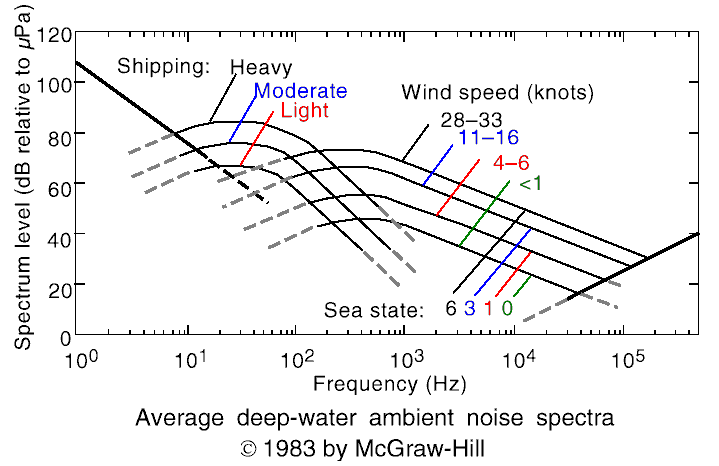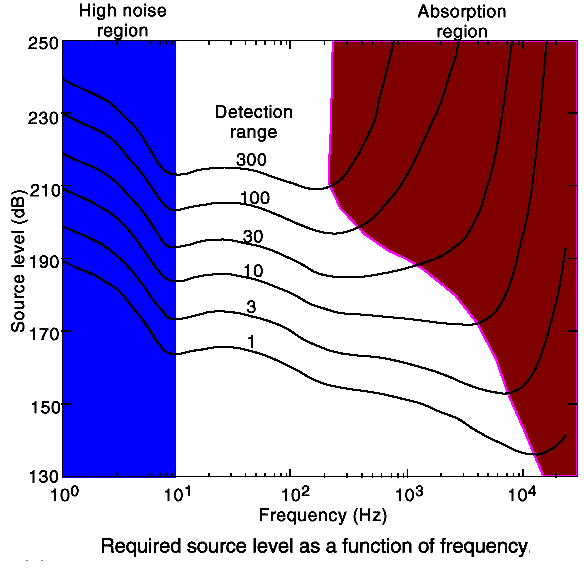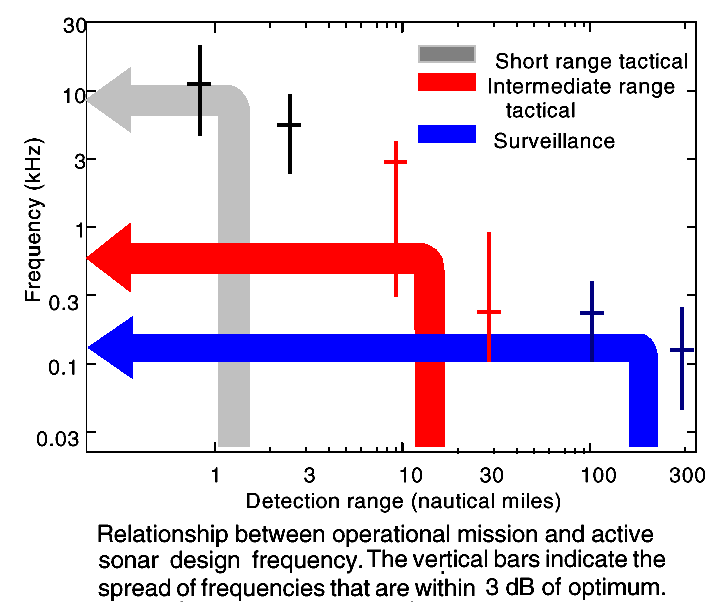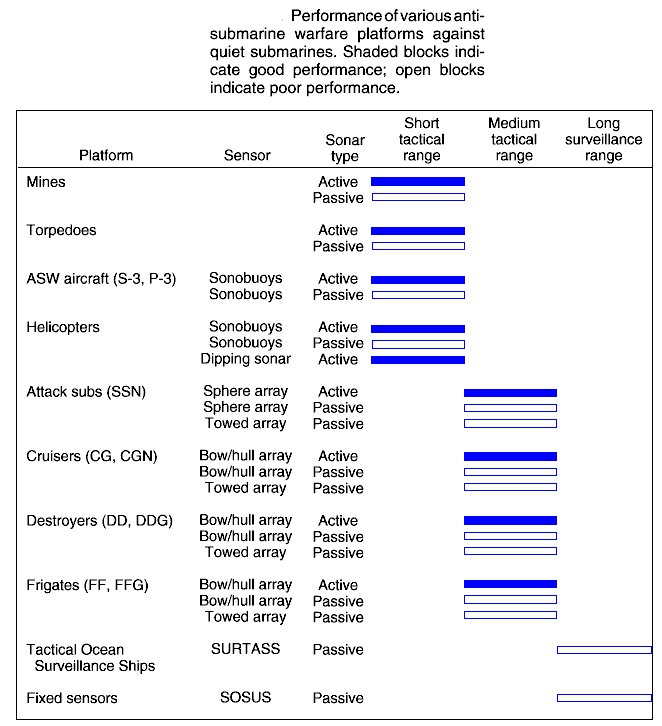


The US ASW forces include a variety of acoustic sensors installed on air, surface, and subsurface platforms, as well as those at fixed geographic locations.
These systems support Navy missions in broad ocean surveillance, detection, classification, localization, and prosecution.
The levels of ship-generated and wind-generated ambient noise are a functions of shipping density, wave height or sea state, and frequency. Values for heavy shipping and sea state level 6 are of interest, since an operational sonar must be designed to perform against expected worst-case conditions.
 The lowest point on each curve corresponds to the �optimum� frequency, in the sense that
it is the least amount of source power required for the system to achieve detection. Size and weight constraints for the source are a major factor in determining sonar system feasibility. For example, the experimental Low Frequency Array system weighed approximately 100,000 pounds, and required one megawatt of power-generation capacity. For
every 3-dB increase in source level required, these numbers double. Optimum frequency becomes lower as the detection range increases. At very short ranges (one to three nautical miles), the optimum frequency occurs in the kilohertz portion of the spectrum, whereas at long ranges the optimum frequency drops into the hundreds of hertz. The upper-frequency cutoff is driven mainly by the absorption term in transmission loss. The engineering design of the array becomes more difficult at very low frequencies. For example, at 1000 Hz, a 20-dB array is approximately 250 feet long. The same gain array at 10 Hz would be 25,000 feet in length. Coupled with engineering considerations for extremely low frequency system designs (very long receive arrays and extremely large, heavy sources), the region below 10 Hz is probably not interesting for an operational system.
The lowest point on each curve corresponds to the �optimum� frequency, in the sense that
it is the least amount of source power required for the system to achieve detection. Size and weight constraints for the source are a major factor in determining sonar system feasibility. For example, the experimental Low Frequency Array system weighed approximately 100,000 pounds, and required one megawatt of power-generation capacity. For
every 3-dB increase in source level required, these numbers double. Optimum frequency becomes lower as the detection range increases. At very short ranges (one to three nautical miles), the optimum frequency occurs in the kilohertz portion of the spectrum, whereas at long ranges the optimum frequency drops into the hundreds of hertz. The upper-frequency cutoff is driven mainly by the absorption term in transmission loss. The engineering design of the array becomes more difficult at very low frequencies. For example, at 1000 Hz, a 20-dB array is approximately 250 feet long. The same gain array at 10 Hz would be 25,000 feet in length. Coupled with engineering considerations for extremely low frequency system designs (very long receive arrays and extremely large, heavy sources), the region below 10 Hz is probably not interesting for an operational system.
 Very short range acoustic sensors with detection ranges of a few kiloyards, such as mines, torpedoes, and air-deployed sensors, are typically utilized for final localization and prosecution. Intermediate detection ranges, from miles to tens of miles, are generally required for surface-ship ASW missions (such as area sanitization or Battle Group defense against the torpedo threat), and by attack submarines for counterdetection of threatening submarines.
Currently, the ASW systems supporting these missions are composed of hull- and bow-mounted active and passive sonars and by tactical towed
arrays. Surveillance ranges are necessarily hundreds of miles to be effective for broad ocean surveillance. The United States has both fixed and mobile large-aperture
passive acoustic arrays in its surveillance inventory.
Very short range acoustic sensors with detection ranges of a few kiloyards, such as mines, torpedoes, and air-deployed sensors, are typically utilized for final localization and prosecution. Intermediate detection ranges, from miles to tens of miles, are generally required for surface-ship ASW missions (such as area sanitization or Battle Group defense against the torpedo threat), and by attack submarines for counterdetection of threatening submarines.
Currently, the ASW systems supporting these missions are composed of hull- and bow-mounted active and passive sonars and by tactical towed
arrays. Surveillance ranges are necessarily hundreds of miles to be effective for broad ocean surveillance. The United States has both fixed and mobile large-aperture
passive acoustic arrays in its surveillance inventory.

Developed in an era of noisy submarines, the US ASW systems performed extremely well against the Soviet order of battle for which they were designed. Introduction of the quieter Soviet submarine, and the addition of Third World diesel�electric submarines to the inventory of possible threats, have significantly degraded the effectiveness of US passive acoustic sensors. Short-range tactical missions are only modestly affected because of the reliance on high-frequency active acoustics as well as nonacoustic sensors (e.g., magnetic anomaly detection). Medium-range tactical missions can be more significantly impacted. The lack of an adequate passive sonar capability for surface-ship ASW operations will influence tactics and significantly degrade overall mission effectiveness for covert and longer-range operations.

For high-speed and noncovert ASW operations, active sonars will continue to provide acceptable perfor-mance despite submarine noise reduction. Attack submarine operations, however, critically rely on the passive acoustic detection advantage possessed by US nuclear submarines. This advantage has been diminishing against the quiet threat posed by these newer submarines as the US strategy of countering larger numbers of hostile
below 10 Hz, the optimum system design frequency and the required source level are at issue, because the uncertainties in the sonar equation are great enough to shift the
local SL minimum within these bounds. For this reason, research and development programs were initiated by the Navy to resolve uncertainties in the sonar equation parameters for low-frequency active sonars.
The real situation is complicated, and when more realism is built into the sonar equation, significant variability is introduced. Although general conclusions about the existence of an optimum design frequency lying between low-frequency noise and high-frequency absorption cutoffs remain valid, a best-design frequency is less obvious. Sonar engineers must necessarily understand detailed characteristics of each term in the sonar equation to produce designs that are effective against variations in the target and the ocean medium.
Sources and Resources
http://www.fas.org/man/dod-101/sys/ship/weaps/sonar.htm
Maintained by Robert Sherman
Originally created by John Pike
Updated Saturday, December 12, 1998 7:17:49 AM







